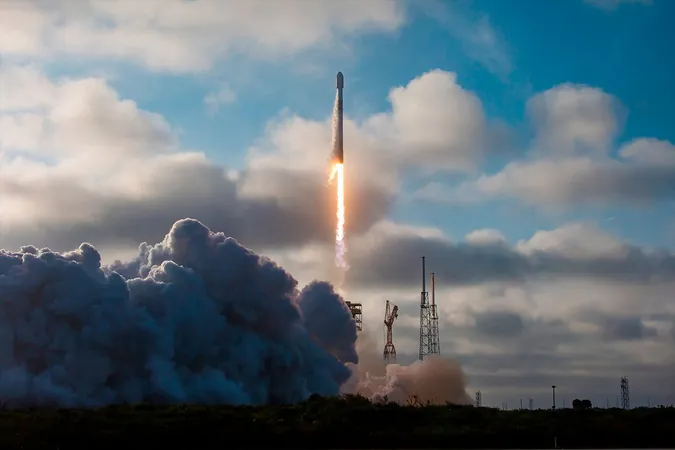
Zwicky Transient Facility Discovers Over 10,000 Supernovae: A New Era in Astronomy!
2024-12-17
Author: Benjamin
Introduction
Astronomers are buzzing with excitement as the Zwicky Transient Facility (ZTF) has successfully classified more than 10,000 supernovae, shedding light on these explosive cosmic events that play a crucial role in the universe. Even for laypeople, it's easy to understand that supernovae—massive stars that violently end their life cycles—are amongst the most dramatic phenomena in the cosmos.
The Zwicky Transient Facility
The ZTF is a groundbreaking wide-field survey named after the influential Swiss astronomer Friedrich Zwicky, who, along with Walter Baade, introduced the term ‘supernova’ in the early 1930s. This facility utilizes advanced optical and infrared technologies to detect and analyze transient astronomical phenomena—objects that significantly change brightness or position rapidly—like supernovae that can temporarily outshine entire star systems.
Achievements and Discoveries
Since its Bright Transient Survey (BTS) began in 2017, the ZTF has, remarkably, uncovered 100,000 potential supernovae, leading to the classification of over 10,000 events spanning different distances, types, and brightness levels. Christoffer Fremling, a staff astronomer at Caltech, highlights the significance of this achievement, noting that trillions of stars exist in our universe, with one exploding approximately every second. The ability to catalog these events showcases the extraordinary progress in astronomical observation and data analysis.
Historical Context
The endeavor of tracking supernovae dates back more than a decade, gaining momentum with the establishment of dedicated astronomical databases in 2012. The ZTF has driven the classification efforts, contributing to nearly 16,000 observed supernovae to date.
Historically, the first documented supernova was noted by Chinese astronomers in 185 AD, making it shine like a ‘guest star’ for eight months. Since then, monumental discoveries have marked the field, such as the explosion of SN 1987A in the Large Magellanic Cloud, which was pivotal for neutrino astronomy.
Operational Technology
Operating nightly, the ZTF employs two telescopes to scrutinize the cosmos, detecting everything from nearby asteroids to distant gamma-ray bursts. Its innovative imaging technology utilizes a 60-megapixel wide-field camera to scan the visible sky every two nights. The team then processes these images, using another telescope called the Spectral Energy Distribution Machine (SEDM) for in-depth analysis.
Machine Learning and Automation
With advancements in machine learning, the ZTF has developed automated systems, like the BTSBot, to assist with the overwhelming volume of transient detections. Remarkably, this system can detect some of the brightest supernovae before human astronomers even have the chance to analyze them.
Notable Discoveries
Amidst the multitude of supernovae tracked, specific discoveries stand out. The ZTF has identified thousands of Type Ia supernovae, which occur in binary star systems, with one star siphoning material from a white dwarf until it explodes. One notable event, SN 2022qmx, was magnified by gravitational lensing from a foreground galaxy, making it appear 24 times brighter than expected.
Collaborative Efforts
The ability to share rapid detection data with other observatories worldwide is vital. Since 2016, the Transient Name Server (TNS) has coordinated the announcement and classification of over 150,000 transient events, fostering a collaborative approach that prevents duplicated efforts in the scientific community.
Future Prospects
In just a few months, the ZTF will join forces with the upcoming Vera Rubin Observatory (VRO), which is set to be operational soon. The VRO aims to conduct a ten-year Legacy Survey of Space and Time, promising to significantly increase the detection of transient astronomical events. This partnership heralds a new age of sensitivity and discovery in time-domain astronomy.
Mansi Kasliwal, a professor at Caltech and the upcoming leader of ZTF, emphasizes the exciting potential of combining observations from both ZTF and VRO. The collaborative efforts may lead to significant breakthroughs in understanding the physics behind supernovae and exploring fast-moving cosmic phenomena.
Conclusion
In a time of unprecedented advancements in astronomy, the exciting discoveries made by the ZTF and the anticipated capabilities of the VRO set the stage for a golden era of exploration and understanding in the universe. Stay tuned as we continue to track these cosmic wonders!









 Brasil (PT)
Brasil (PT)
 Canada (EN)
Canada (EN)
 Chile (ES)
Chile (ES)
 España (ES)
España (ES)
 France (FR)
France (FR)
 Hong Kong (EN)
Hong Kong (EN)
 Italia (IT)
Italia (IT)
 日本 (JA)
日本 (JA)
 Magyarország (HU)
Magyarország (HU)
 Norge (NO)
Norge (NO)
 Polska (PL)
Polska (PL)
 Schweiz (DE)
Schweiz (DE)
 Singapore (EN)
Singapore (EN)
 Sverige (SV)
Sverige (SV)
 Suomi (FI)
Suomi (FI)
 Türkiye (TR)
Türkiye (TR)